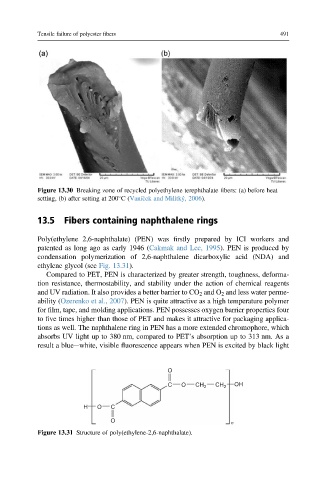Page 518 - Handbook of Properties of Textile and Technical Fibres
P. 518
Tensile failure of polyester fibers 491
Figure 13.30 Breaking zone of recycled polyethylene terephthalate fibers: (a) before heat
setting, (b) after setting at 200 C(Vaní cek and Militký, 2006).
13.5 Fibers containing naphthalene rings
Poly(ethylene 2,6-naphthalate) (PEN) was firstly prepared by ICI workers and
patented as long ago as early 1946 (Cakmak and Lee, 1995). PEN is produced by
condensation polymerization of 2,6-naphthalene dicarboxylic acid (NDA) and
ethylene glycol (see Fig. 13.31).
Compared to PET, PEN is characterized by greater strength, toughness, deforma-
tion resistance, thermostability, and stability under the action of chemical reagents
and UV radiation. It also provides a better barrier to CO 2 and O 2 and less water perme-
ability (Ozerenko et al., 2007). PEN is quite attractive as a high temperature polymer
for film, tape, and molding applications. PEN possesses oxygen barrier properties four
to five times higher than those of PET and makes it attractive for packaging applica-
tions as well. The naphthalene ring in PEN has a more extended chromophore, which
absorbs UV light up to 380 nm, compared to PET’s absorption up to 313 nm. As a
result a blueewhite, visible fluorescence appears when PEN is excited by black light
O
C O CH 2 CH 2 OH
H O C
O
n
Figure 13.31 Structure of poly(ethylene-2,6-naphthalate).

